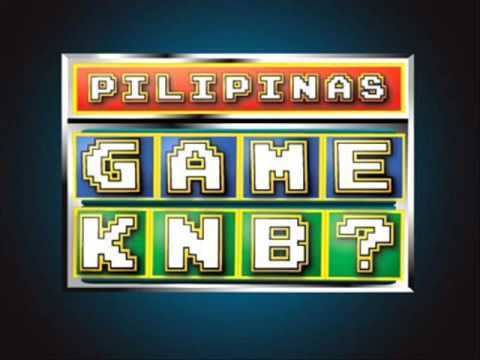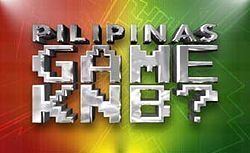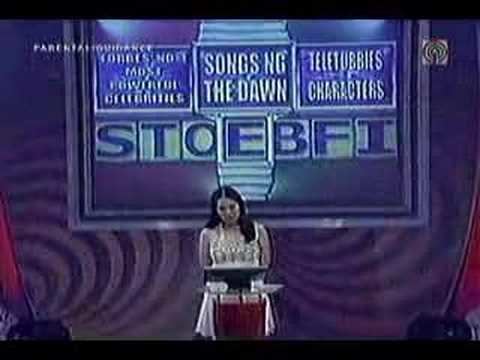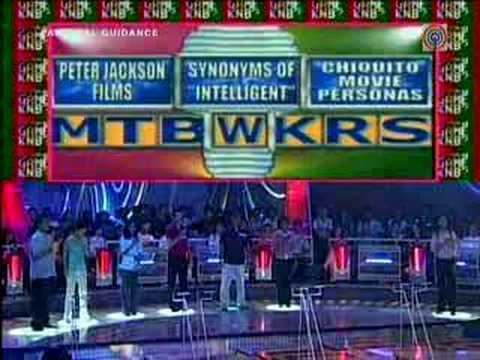9 /10 2 Votes
Genre Game show Directed by Bobet Vidanes No. of seasons 7 Final episode date 23 October 2009 Number of seasons 7 | 8.1/10 IMDb Created by ABS-CBN Country of origin Philippines First episode date 1 October 2001 Program creator ABS-CBN Number of episodes 2,091 | |||||||||||||||||||||||||||||||||
 | ||||||||||||||||||||||||||||||||||
Starring Kris Aquino (2001–2007) Edu Manzano (2007–2009) Awards PMPC Star Awards for TV Best Game Show, PMPC Star Awards for TV Best Game Show Host Similar Daisy Siete, Game show, Boy & Kris, Wowowee, SiS | ||||||||||||||||||||||||||||||||||
Pilipinas, Game Ka Na Ba? stylized as Pilipinas, Game KNB? was a Philippine game show by ABS-CBN which aired from 2001 to 2009. The show was hosted initially by Kris Aquino and was replaced by Edu Manzano in the latter versions. It was also aired on The Filipino Channel. The show was broadcast from ABS-CBN Studio 8 in Quezon City.
Contents
- Main hosts
- Kris Aquino era
- Edu Manzano era
- Game formats
- Game Ka Na Ba 2001 2002
- Milyun Milyon Na Game Ka Na Ba 2002 2003
- Next Level Na Game Ka Na Ba 2003 2004
- Pasko Na Game Ka Na Ba 2005 2008
- Pilipinas Game Ka Na Ba 2004 2009
- 2004 2006 Pyramid Format
- 2006 2008 Atras Abante Format
- 2008 2009 Word Picture Format
- 2009 Team Format
- Reception
- Aftermath
- Papaya Dance
- Taglines
- Awards
- References

The KNB in the stylized title of the game show literally means "ka na ba" or "are you" in English, making the full title "Pilipinas, Game Ka Na Ba?" (literally, Philippines, Are You Ready [to Play]?). The KNB is derived from standard practice in text messaging to make messages as short as possible when typed.

Main hosts
Kris Aquino era
Guest co-hosts of Next Level Na, Game Ka Na Ba?
Edu Manzano era
The following hosted the 7th anniversary special of Pilipinas, Game Ka Na Ba? on November 10–15, 2008
Game formats
Pilipinas, Game Ka Na Ba? has undergone several formats throughout its 8-year run:
Game Ka Na Ba? (2001-2002)

In Game Ka Na Ba? which was stylized as Game KNB, the contestant needed to get three out of five correct answers to get to the next round, and each round, the prize became higher (this incarnation was closest in format to Who Wants to Be a Millionaire?). The player also can change his initial answer until he replies "Sure na" (I am sure) when the host asks him "Sure KNB?" (Are you Sure?), similar to the "Is that Your Final Answer" in Who Wants to Be a Millionaire?. The showcase round had 4 possible choices, P300,000 round had 3 possible choices, and the P500,000 round had 2 possible choices. The P1,000,000 round on the other hand had no choices but is only composed of one question which was based on one of the contestant's major interests. The contestant had a chance to go home with their current winnings between rounds. The show quickly became one of the highest rated primetime game shows in the Philippines.
Milyun-Milyon Na, Game Ka Na Ba? (2002-2003)

Due to the success of Game Ka Na Ba?, an updated version, Milyun-Milyon Na, Game Ka Na Ba? (Milyun-Milyon Na, Game KNB?) debuted later that year. The only major difference was that the jackpot increased by PHP100,000 every time a player did not win it. The show was only supposed to be a week-long special, but its popularity caused it to become the permanent format for the show until 2003. It gained popularity when they gave away PHP3,500,000 to a studio player and a home player (totalling PHP7,000,000), said to be the biggest prize ever to be given on Philippine television history.
Next Level Na, Game Ka Na Ba? (2003-2004)
In 2003, Next Level Na, Game Ka Na Ba? (Next Level Na, Game KNB?) debuted. It roughly was the same format as Milyun-Milyon Na, but physical and luck-based games were added in addition to the regular question based games which were carried over through the last 2 versions. The next relaunch to the most recent format occurred in 2004 but aired in the daytime block and happened to be a ratings success.
Pasko Na, Game Ka Na Ba? (2005-2008)
In December 2005, ABS-CBN aired a special primetime Christmas version of Pilipinas, Game Ka Na Ba? called Pasko Na, Game Ka Na Ba? (Pasko Na, Game Ka Na Ba), where celebrities played for charity, which carried on the Pyramid format. In honour of the show's sixth anniversary in November 2007, Pasko Na, Game Ka Na Ba? was revived for two-weeks carrying on the Atras-Abante format.
Pilipinas, Game Ka Na Ba? (2004-2009)
The show has gone several contest formats. Host Edu Manzano revealed that the yearly changing of formats was because they want to retain their audience by taking away the "sawa" (lit. getting disinterested over something due to frequent exposure) factor.
2004-2006: Pyramid Format
This format makes use of the pyramid stage and the Tarantarium. The Tarantarium is a room filled with a wide selection of books and other reference materials that the 10 contestants chosen via electronic raffle and text registration will be housed before the show starts and thus will be introduced. Each contestant was given 30 minutes to review different topics for the questions to be asked in the game's elimination round (somewhat like taking an exam). A maximum of 2 questions (with the early versions as "One-on-One Tayo" and "Dibdiban Na!") will be asked to every contestant and if the answers are at least both correct, the first 4 people will move on to the next round, but if wrong (either in the "One-on-One Tayo" or both questions in the later version) shall the contestant be eliminated, regardless if the first 4 were already called.
The pyramid stage was designed to look like an actual pyramid composed of 15 hexagons (resembling like a honeycomb, with reference to the show's logo) wherein the stage has 2 of it: one for the contestants and the other is a backdrop, and it tracks the path of the contestant throughout the entire stage. Every contestant will answer a series of questions and once right, shall move up until reaching the top, but his/her path may change if there would be a challenge offer wherein the contestant must say "Umalis Ka!" and thus shall be given a question, if right shall steal the spot of the contestant who was originally placed there and take one step back, but if wrong shall remain in that spot. The first contestant who reaches the top first will be given an automatic prize of P50,000 and a chance to beat the defending winner. A clincher round will decide on who will be playing for the Million Peso Jackpot Round, by the defending winner choosing a certain category with a question that has something to do with it, and by the challenger enumerating all of the correct answers. If the challenger gives all the correct answers, he/she will be declared as the winner and will keep the prize but failure to do so shall the contestant will take home only half of the P50,000 prize, by not giving all answers correctly, and the defending winner advancing towards the round.
The winner of the clincher round advances to the Million Peso Jackpot Round, wherein he/she will be choosing a category (e.g. Arts & Literature, Geography & Nature etc.) where the question will be based. The contestant shall be given the use of the Tarantarium for only 60 seconds and once time is up shall answer the question. If wrong, he/she will have to return in the succeeding episodes and increase his/her winnings but if right, will be taking home P1,000,000 and a new defending winner will be named.
2006-2008: Atras-Abante Format
The show's pyramid format was decided to be shelved and be replaced by a new format. This format was aired in 2006, and this was the last format that Aquino would be hosting. On March 6, 2007 then-Optical Media Board (OMB) chairman Edu Manzano replaced her due to her pregnancy leave from her shows on ABS-CBN and this was for good.
The format carried on some aspects of the pyramid format, particularly they would have to succeed the defending winner. There are 10 contestants who registered via text messaging and would compete at an elimination round wherein only half of them would advance to the next round. The elimination round is played by the contestants, wherein 9 categories and certain letters of the alphabet are randomly selected. The letters correspond to the first letter of the answer about the certain category. Those who answer correctly would be moving on, but those who got it wrong will not be eliminated, but others would try to steal to answer.
In the second round, this is called the Atras-Abante round, wherein the 5 contestants from the elimination round would answer series of questions and the 2 contestants reaching the Yellow Line would move on to the next round, but the first one who would reach the line first would receive an additional P10,000. Each contestant who answers correctly has 2 options: He/She would say "Abante Ako!" and will advance one step (with a maximum of 4 steps in order to reach the Yellow Line) or would say "Atras si...!" and would have the choice to move back one or two players from their current position since they only have 2 Atras Powers and thus would say "Abante Ako!".
The 2 contestants who reached the Yellow Line first in the Atras-Abante round would go on head-to-head-to-head with the defending winner in a Knock-Out Round. 3 categories are shown and the defending winner selects one and the question would be coming from that certain category. Each would be given 20 seconds to think and they would take turns in answering, depending on how many correct answers the host needs. If a contestant gives an answer that is wrong, say an answer repeatedly or do not answer at all, the contestant or defending winner will be eliminated and shall take a step back. The player who gives all correct answers will receive an additional P30,000 while the last player who answers correctly will move on to the P1,000,000 Jackpot Round and will receive an additional P50,000. The other two players who do not advance would take consolation prizes of P10,000 and P20,000 respectively.
In the P1,000,000 Jackpot Round, the defending winner (whether new or old) will be given 8 categories and has 10 seconds to read all of them. After that, there would be 6 letters wherein 3 are already given and the contestant would be given an additional 3 more. These letters are really significant, because these are the first letters of the possible 6 answers of a randomly selected category. The goal is to get all 6 of them correctly in 60 seconds in order to win the P1,000,000 jackpot. In the event that the contestant would not get all 6 correctly, he/she would draw a bonus letter (this letter should be a correct answer from the 6) and if so, shall take home a special prize. This installment would be carried on in the succeeding formats. The defending winner would defend his/her title in the succeeding days.
2008-2009: Word & Picture Format
The show starts with the elimination round. 30 contestants are situated in the gallery, one of them being a defending champion. A contestant is randomly chosen to answer a question. The player is eliminated if they get the answer is wrong. Once 4 players are selected, the champion gets a question. If the player doesn't get it right, more players are randomly chosen to answer the question until someone gets it right. The 5 players go on to the next round, anyone who did not get chosen to answer a question do get to return the next episode to compete again.
The next round is the Pick-A-Word round, wherein an LED screen features 9 clue words to 9 different questions, each with a different value (either P1,000, P3,000 and P5,000). The first question and amount is chosen at random, and all others are chosen by the player. If the question is answered correctly, points are earned, and if it is not, points are lost. Scores are represented in a numerical form, and in the form of platforms which raise or lower the player accordingly as well. The 3 players with the highest scores go to the next round, and the remaining players take home as money equal to half their score. Below is an example of how the board is on this round:
The Take-A-Pic round works almost exactly like the previous round, except pictures of people are used instead of words, and the amounts are higher (either P5,000, P7,000 and P10,000). The highest scoring player goes to the final round, and the remaining take home as money equal to half their score. Below is an example of how the board is on this round:
In the final round, 9 words are given. The player picks a word, then ask 7 questions themed around that word. If the 7 questions are answered correctly, the grand prize of 1 Million pesos is won. However, if the player does not get all 7 right, the player must pick from a set of envelopes, each containing the letters G,A,M,E,K,N and B, which corresponds to one of the questions. If the player picks one corresponding to a question he or she got right, the player wins a showcase of prizes.
2009: Team Format
This format has been conceptualized and announced late 2008, and is a spin-off of the old Game Ka Na Ba group format and was launched on April 13, 2009. This time, more challenging rounds will test eight teams of three vying for the bigger prize of 2 million pesos (around $40,000). The game now consists of four rounds, namely the "Elimination", "Taranta" (Panic), "Diskarte" (Strategy), and Jackpot rounds. This new format shows a fresh combination of thrills, luck, teamwork, and excitement.
The elimination round will be started off by eight team players, composed of the previous episode's defending champion, and seven teams composed of those from the past episode (those who failed to answer for the elimination) and replacement teams for those who got eliminated from the previous episode. Each team is composed of three individuals, the game texter (the one who sent the text entry for studio contestant) and two chosen teammates.
Each team are geared up to be the first to run to and press their respective buzzers as team. If a team answers correctly, he will move on for the 2nd round. If the team answers incorrectly, they will be sent to the "Tambay (Standby) Podium" to wait for any chance of being sent back to the game stage. Any "Tambay Podium" team can go back to the game if there's only one team left in the game platform but still no one to complete the 4 teams to move on for the 2nd round. Any "Tambay Podium" team is considered eliminated from the game, and won't come back for the next episode, unless saved by the shortage of Round 2 teams. This round tests each team's agility and quick-thinking abilities.
Successful teams from the elimination round will be asked to sit on hydraulic seats, similar to those seen in roller-coasters, to play "Taranta Round". All teams will be asked one question, but each individual will be given three different sets of choices. The order of answering individuals is random. Some questions might be harder than it sounds, thus adding the Panic Factor in the game. To add up for the distractions delivered by the game's lightings and music, each player will be sprayed with water and air, making it more difficult for each player to give the correct answer in the given 3-second timeframe. The top 2 teams with the highest number of correct answers will advance to the next round.
In case a tie comes up, the tied teams will be given another question, this time selecting the one that doesn't belong to the group the question describes. Each team should select one member to serve as buzzer person. The buzzer person should beat other team's buzzer persons by activating the sensor first and answering the question correctly. The two losing teams will be eliminated and won't be taken over to the next episode. This round tests each team's fortitude under pressure. This round also has the most "luck factor" in it.
The two remaining teams, who already won 15,000 pesos (approx. $300) will battle head on for the Jackpot round through the Diskarte Round. Each team member will be placed on top of individual mobile podiums, and are obliged to answer questions to win this round. A correct answer will advance the team member one "stage" near the final platform through the mobile podium (it moves forward towards the final platform). If one member arrives to the third "stage" first, he / she gets 10,000 pesos (approx. $200) as individual bonus prize. When a team member is already at the third "stage", his next correct answer will enable him / her to advance other co-members one stage forward. When all team members has already reached the third stage, they would need one last correct answer to win the round.
As an added twist, each team are given three "Diskarte Powers" that could be inflicted to the opposing team.
All of the strategy powers stated above will test the team's ability to strategize and size up their opponents. This round will also test teamwork and fast-thinking.
The final round, when completed successfully, will award the team 2 million pesos cash (approx. $40,000). The team will be asked seven questions, no multiple choices, and they only need to answer 5 out of 7 questions to win the 2 million. Each question starts by mentioning their categories. A team member familiar with the category will need to say "Mine!" first before pressing his / her own assigned buzzer. After saying "Mine!", the question will be revealed, and the team member responsible should provide an answer. If the team member is sure about the answer, he should say "Sure Na!" (I'm sure!) before it gets locked as final answer. If the team member isn't sure about the answer, he could consult the team for the answer and have them coach him, or have another member say "Mine!" and steal the responsibility of answering the question. The team needs to answer these questions within 90 seconds.
Reception
"Pilipinas, Game Ka Na Ba?" consistently achieved high viewership ratings during its prime time slot on ABS-CBN, often ranking first in its category, largely due to its popularity as a phenomenon in the Philippines. Additionally, during its daytime broadcast, the show maintained strong ratings, frequently securing the second position in daytime viewership. This success was attributed to its lead-in show "Wowowee," also on ABS-CBN, and the fact that the show produced over 20 millionaires.
Aftermath
According to an article by Philippine Entertainment Portal (PEP.ph) in October 2009, "Pilipinas, Game Ka Na Ba?" will return as a "seasonal" show like the other shows of ABS-CBN like "Kapamilya, Deal or No Deal" and "The Singing Bee". Although, the issue of the game show's return is blurry since Edu Manzano transferred to ABS-CBN's rival network, GMA Network. ABS-CBN also launched a new show called Showtime (which was later slightly renamed as It's Showtime) and it also happens to perform very well in the Philippine national television ratings.
Papaya Dance
A meme started by Game Ka Na Ba is the "Papaya Dance". In a previous version of the show, the "atras-abante" round was used to select the 2 players who would compete for the grand prize. The first player who made it to the round danced the tune of Papaya, a '70s pop jazz song by Urszula Dudziak. Due to the popularity of the song, Edu Manzano released a soundtrack, which became a certified hit, and was even used as part of the soundtrack of Star Cinema's movie Sakal, Sakali, Saklolo. After a few months, the Papaya dance became known worldwide when it was featured on MSNBC, Reuters, and ABC's Good Morning America.
Taglines
On Kris' Aquino's reign as Game Ka Na Bs? host, she managed to make an impact of famous taglines from the show that are somewhat became a very known expression for Filipinos, words like "Korek!" or "May Tama Ka!". "Korek!" (Correct!) have been one of the most known expression taken from the show, it mentioned all the time by Aquino every time a player answers a question correctly. In Filipino pop culture, this expression is used to say if someone have said something correctly, but then it is said in a very joyful tone. "May Tama Ka" (You have a right answer!) is used when players are in the "Atras Abante", every time a player gets a correct answer, they get a "check", the player with the most number of correct answers wins. On Filipino pop culture, "May Tama Ka" is an expression used when somebody sarcastically tells a person that they are right. Sometimes, it is also used to tell people that they are like "crazy", as in being stupid.
